About Everything
Necessitous News
Offsite Links
Comical Characters
Tresspass Act (Ont.)
Peregrination
Buildings
»Storm Drains
Barrie (Ont.)
Backbone
Bad Portent
Black Hearts
Conspiracy Drain
Flowstone Caverns
Great Manwhore
Happy Hour
Harvey Drain
Icebox
Queen's Drain
Sunnidale
Swift Lift
Trashy Drain
Trashy II
Wet Nightmares
Toronto (Ont.)
Arachnoslide
North Park
York Mills
Transit & Utility
Construction
Expeditions
Palavering
Sign Guestbook
View Guestbook
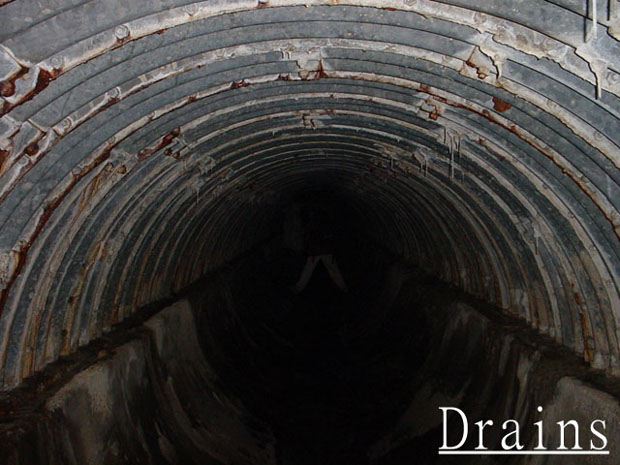
Rivers, streams, and other such beautiful natural waterways are all well and good, except when they get in the way of good old-fashioned human expansion. The sad fact is that most streams that stray too close to a modern city are usually diverted, piped away and paved over with no quarter given. The few signs of this left top-side are generally taken for granted: gutterboxes, grates, manholes, pipe mouths in ditches and outpours in holding basins. A few feet beneath these mundane features, however, things are far more interesting.
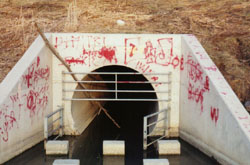 Storm drains are tunnels run under a city designed to divert rivers to
designated
areas, in order to reclaim the land they take up and provide a network to
drain rainwater that collects on the streets. These are a completely
different
beast than the oft-maligned "sanitary sewers", which are the exclusive
carriers of raw sewage, foul water and other such euphemisms for "crap".
Those we stay away from. On the other hand, storm drains, which normally
carry only rainwater
and street runoff, are considered fair game for exploration.
Storm drains are tunnels run under a city designed to divert rivers to
designated
areas, in order to reclaim the land they take up and provide a network to
drain rainwater that collects on the streets. These are a completely
different
beast than the oft-maligned "sanitary sewers", which are the exclusive
carriers of raw sewage, foul water and other such euphemisms for "crap".
Those we stay away from. On the other hand, storm drains, which normally
carry only rainwater
and street runoff, are considered fair game for exploration.
Why? Because they're there! Storm drains, from the unremarkable round
concrete pipes of our home city, to the ridiculously oversized cavernous
wonders in Australia, are somewhere that few people actively think about and
even fewer actually venture into. This is a shame, because within these
man-made caves one can find all sorts of sights that you'd never expect to
have been under your feet all this time. Mineral deposits, stalactites,
ice, graffiti from past explorers, huge chambers, ladders, balconies, pits,
slides, spiders, and all manner of other features can be found in the storm
drains of your city. In a drain one finds experiences completely new to
someone who's spent their life topside -- venture a few hundred feet into a
drain, switch your light off and look around you. It's pitch black, not a
photon to be found. There is almost nowhere topside in a modern city that
is ever as dark as within the depths of a storm drain. Listen to the
sounds -- the running water, the echoing footsteps. Give a woop down a
tunnel and you'll hear it come back at you a full second later. The sight
of two small beams of light, the only light to be had, shining through the
humid air from a manhole several feet above you is unforgettable.
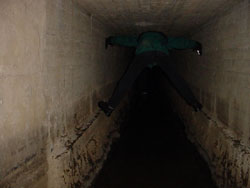 Everything is different underground -- things like the
thump-ump of cars hitting manholes over your head, or the occasional
surreal conversation with someone who hears you and your partners conversing
beneath
a grate and yells into it, not quite believing that he's shouting into the
ground. The looks passers-by give when a manhole on the sidewalk suddenly
lifts itself out of its collar and a troupe of drainers emerge, nod, slip
the lid back into its place and walk away is priceless.
Everything is different underground -- things like the
thump-ump of cars hitting manholes over your head, or the occasional
surreal conversation with someone who hears you and your partners conversing
beneath
a grate and yells into it, not quite believing that he's shouting into the
ground. The looks passers-by give when a manhole on the sidewalk suddenly
lifts itself out of its collar and a troupe of drainers emerge, nod, slip
the lid back into its place and walk away is priceless.
There are a certain number of things one should be sure to take on a
draining expedition. First, and most obvious, is a light source.
Photons are a rare and precious resource in the tunnels, so if you're
venturing in you've got to be sure that you've got a reliable light. An
ideal flashlight is waterproof and won't sink, as well as having a long
lifespan -- both bulb and batteries. Drains are a tough environment on
lights and your average NoName Brand Dollar Store Flashlight (TM) will work
for one trip (maybe) but it won't last much longer than that. Corrosion,
bumps and splashes are just a few of the nasty things your flashlight will
be exposed to so don't be cheap. Currently UEC is having a blast with a
flashlight recently put out by Radio Shack -- a tiny, portable clip-on light
with two high-intensity white LED's that runs from three AAA batteries.
It's highly recommended if you can find it -- the light output is more than
sufficient for a drain and the battery life can be in excess of eighty
hours. The LED's themselves will almost certainly last longer than the rest
of the light does, so bulb-changing is a non-issue. In fact, you should
always use LED lights when they're available. Screw incandescents --
they're glorified space heaters. LED lights are more reliable, use less
energy and produce less heat. They're more shock-resistant and last longer.
Use them. If Mag-Lite would produce a good LED flashlight with the usual
fantastic body construction, I'd sell all my other light sources.
At any rate, while draining alone is fun and an interesting experience in
and of itself, it is highly advisable to always bring a friend or
two. If you're wounded or incapacitated while by yourself in a drain,
you're basically screwed. Having a partner on an excursion means there's
someone to go for help or get you out. Either way, you should generally
tell someone where you're going before you go into a drain, in case you
don't come back. Er.
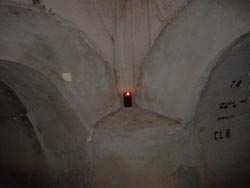 Other equipment that's good to have in a drain includes rubber boots,
crowbars, crayons (if you're the tagging type), and rope. Improvise --
bring whatever you think you'll need and make up your own list for
excursions that strikes a balance between weight and utility.
Other equipment that's good to have in a drain includes rubber boots,
crowbars, crayons (if you're the tagging type), and rope. Improvise --
bring whatever you think you'll need and make up your own list for
excursions that strikes a balance between weight and utility.
Draining isn't for everyone, and could almost be considered one of the
fringe areas of urban exploration. Some explorers swear by drains and
rarely do any other, top-side targets, whereas other active
explorers avoid drains in general unless they offer something truly
fantastic. Some people are just drawn to it more than others. It's the
"getting wet" part that puts most people off, I believe.
Draining is dangerous, exhausting and requires you to be alert and
responsible, but it also offers many fascinating sights and experiences.
Knowing how to get from place to place in your city from underground is a
unique and nifty thing.
There are many reasons to go into storm drains, but just as many reasons not
to. Draining is a dangerous act -- every time you enter a storm drain,
you're taking your life into your hands. Pollution, bacteria breeding in
stagnant water or in sanitary overflow from a recent storm, heavy water
current, steep falls, unsafe ladders, sharp objects washed in off the
street, and other hazards can be present in varying amounts. If you're in
an urban area, there's a good chance that local industries use them as
convenient venues for illegal dumping of materials you'd probably be happier
not getting mixed up with.
There are several designs of gross pollutant traps, designed to remove large
sediments from the water before it reaches the lake, and they vary from
holes in the floor to elabourate designs that look somewhat like washing
machines from the inside. Among these are the dreaded Stormceptor, a
complex device which spells certain death for any drainer unlucky to find
himself washed into it.
Draining is illegal in most places and in North America is a civic
trespassing charge -- a ticketable offense of up to about sixty dollars.
However, from country to country the laws vary wildly so you'd do well to
check locally.
While there are many good documents on draining which go into full detail
regarding the dangers involved, other things you should be aware of include
the
chance of poisonous or explosive gases, as well as oxygen deprivation.
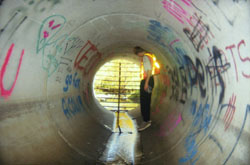 Don't ever drain in the rain ("when it
rains, no drains", as the Cave Clan adage goes), even if you think you know
a drain's watertable intimately. You can still be surprised by a sudden
rush in the current and be knocked off your feet, soaked and dragged along
several feet at best -- at worst you can be completely sucked underwater and
thrown at a high speed over a ten-foot waterfall onto concrete. Draining is
dangerous, and anyone who
wants to try it should be sure that they have the maturity to take the
responsibility for their safety totally into their own hands. There's
nobody trying to keep you alive down there -- like most places in urban
exploration, the drains are a truly wild environment. Take every precaution
and be sensible.
Don't ever drain in the rain ("when it
rains, no drains", as the Cave Clan adage goes), even if you think you know
a drain's watertable intimately. You can still be surprised by a sudden
rush in the current and be knocked off your feet, soaked and dragged along
several feet at best -- at worst you can be completely sucked underwater and
thrown at a high speed over a ten-foot waterfall onto concrete. Draining is
dangerous, and anyone who
wants to try it should be sure that they have the maturity to take the
responsibility for their safety totally into their own hands. There's
nobody trying to keep you alive down there -- like most places in urban
exploration, the drains are a truly wild environment. Take every precaution
and be sensible.
.